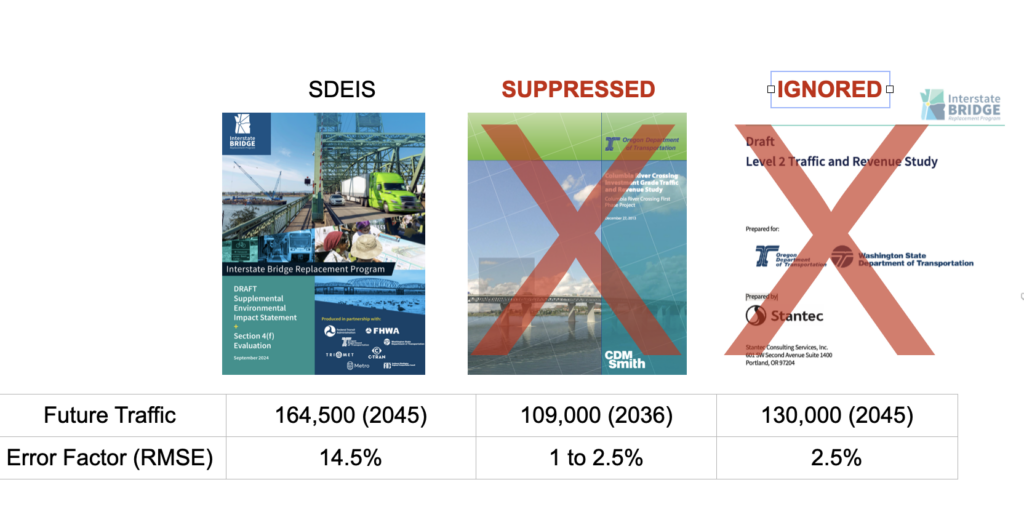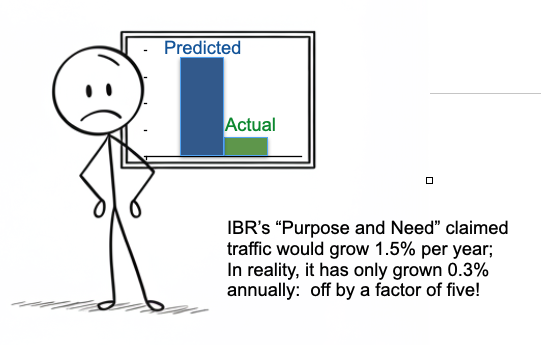What City Observatory Did This Week
IBR Traffic Forecasts Violate Portland Region’s Climate Commitments. Portland’s adopted Regional Transportation Plan commits the Metro area to reduce total vehicle miles traveled by 12 percent over the next twenty-five years. But the traffic forecasts used to justify the $7.5 billion Interstate Bridge Replacement (IBR) Project call for more than a 25 percent increase in driving over that same time period.
The RTP is required under state law to plan for a reduction in VMT per capita; the RTP is the way that regional and local governments show they comply with these state climate requirements. But the IBR planning is predicated on a world where we drive much more and not any less.
Projects like the IBR are required by state and federal law to be consistent with the adopted Regional Transportation Plan, but they are being planned for traffic levels that flatly violate that plan and state requirements.
The Interstate Bridge Project is relying on its least accurate forecast and ignoring or concealing more accurte forecasts it has paid for. Oregon and Washington have commissioned not just one forecast of future traffic levels on I-5 and I-205, but three different forecasts. IBR officials are clinging to the one forecast that is the least accurate, and most error-prone, and have chosen to ignore two more accurate forecasts.
IBR relies on Metro’s Kate Model, which has an error factor of 14.5 percent and which over-estimates I-5 traffic by almost 20 percent. IBR’s DSEIS makes no mention of the Stantec Level 2 forecast (with an error factor of 2.5 percent), or the CDM Smith Investment Grade Forecast (with an error factor of 0.8 to 2.5 percent).
The two states have paid $1.5 million for the CDM Smith Forecast and nearly $800,000 for the Stantec Level 2 Forecast. Using a less accurate forecast and ignoring or suppressing more accurate forecasts in the EIS violates the National Environmental Policy Act.
Needless Purposes: How IBR contrived a false purpose and need to justify its $7.5 billion freeway widening project. The $7.5 billion Interstate Bridge Replacement Project’s two-decade old “Purpose and Need” statement is simply wrong, and provides an invalid basis for the project’s required Environmental Impact Statement.
Contrary to claims by project proponents, the “Purpose and Need” statement isn’t chiseled in stone, rather it is required to be evolve to reflect reality and better information. Yet IBR is relying on a 2005 purpose and need statement that rests on exaggerated traffic forecasts that have been proven wrong.
The IBR’s 2005 Purpose and Need Statement (still forms the basis for the 2024 SDEIS) claimed the I-5 needed to accommodate 1.7 percent more vehicles each year. In reality, traffic growth has been less than a fifth of that amount, 0.3 percent from 2005 to 2019.
For decades, highway builders have been pushing a “predict and provide” paradigm, pretending that we needed to plan for an ever-increasing flood of vehicle traffic, and threatening gridlock if highways weren’t expanded. But these self-serving predictions have consistently proven wrong.
Law and policy require that the “Purpose and Need” statement be reasonable, and not drawn so narrowly as to exclude alternatives, and that the statement evolve over time as conditions change. But IBR is using, nearly unchanged, a two-decade old statement that falsely claims that I-5 must accommodate ever greater traffic.
IBR officials are clinging to an out-dated and simply incorrect purpose and need statement to inflate the size of the project, and to rule out lower cost alternatives with fewer environmental impacts, in violation of NEPA.


